How to Foliar Feed Cannabis Plants
An in-depth guide on how to foliar feed cannabis plants. Discover how to apply nutrients and pesticides with a spray bottle to fix deficiencies and improve yield.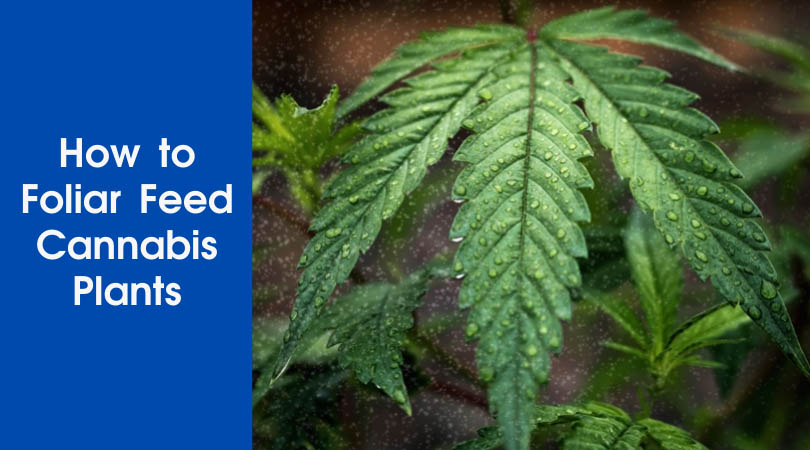 When an emergency strikes your cannabis garden — time is of the essence.
When an emergency strikes your cannabis garden — time is of the essence.
Whether your weed plants exhibit severe nutrient deficiency or a sudden pest outbreak, you don’t have the luxury to hang around thinking about what to do.
Luckily for you, foliar feeding and spraying is an option. Once you’re done reading this informative guide, you’ll know exactly what to do when the time arises to spray down your marijuana crop with yield-boosting nutrients or disease and pest-destroying liquid solutions.
From healthy weed plants to increased yield, there’s no better time than now to learn how to foliar feed cannabis plants.
Let’s begin!
What is Foliar Feeding and Why it’s Important
Foliar feeding or spraying marijuana plants is an effective way to:
- Rapidly get nutrients into cannabis plants during the vegetative stage
OR
- Apply pesticides/herbicides/fungicides on cannabis plants
Unlike traditional feeding methods, liquid solution that’s sprayed onto the leaves is absorbed quickly. Remember, conventional feeding methods are taken up via the root zone, which may take 12-24-hours to stimulate a response in the marijuana plant.
Alternatively, spraying cannabis plants with nutrients will generate a rapid response, especially when marijuana plants experience a nutrient deficiency.
However, foliar feeding is not a replacement for traditional irrigation methods.
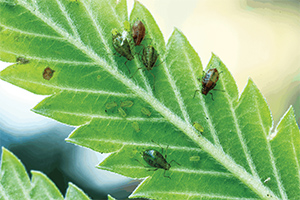
Help protect your cannabis plants from pests with liquid protectant.
As you can see, foliar feeding or spraying is crucial because it gives cannabis cultivators a novel method to apply nutrients or protectant without relying on the root zone.
Here’s a list of benefits of foliar feeding:
- Easy-to-apply
- Cannabis plants uptake foliar fed nutrients quickly and efficiently
- The ideal method to apply insecticide/pesticide/bactericide
- Quickly apply a dose of micronutrients or growth boosters
- Promotes growth of root zone-base microorganisms
- Avoids nutrient/salt-buildup in the root zone
- Pinpoint accuracy
Overall, foliar feeding cannabis plants is a great way to keep your marijuana plants happy and healthy!
When To Foliar Spray Weed Plants
Similar to irrigating cannabis plants — there are ideal times to foliar feed.
Ultimately, cannabis cultivators are left with two options to foliar feed their marijuana crop:
- Morning or when indoor lights turn on
- Evening or right before indoor lights turn off
As you can see, it’s not a good idea to foliar feed cannabis plants during the hottest or brightest time of the day. In other words, always apply foliar fertilizer early, so the nutrient or protectant has time to absorb into the leaves safely.
If you apply foliar fertilizer or protectant during the hottest part of the day or once the grow room is in the middle of “lights-on,” you risk:
- Burning cannabis leaves
- Stunting growth
- Reducing yield
As long as you avoid the hot hours of the day, your weed plants will have time to absorb the nutrient solution or liquid protectant.
Aside from the best time to foliar feed cannabis plants — there’s also the best stage to apply fertilizer spray or liquid protectant. In general, it’s best to foliar feed during:
- The vegetative stage (once per week)
The primary reason you should avoid foliar feeding during the flowering phase is that excessive moisture on cannabis buds may promote bacterial or fungal growth. Therefore, you must only apply foliar spray during the flowering stage in the event of an emergency.
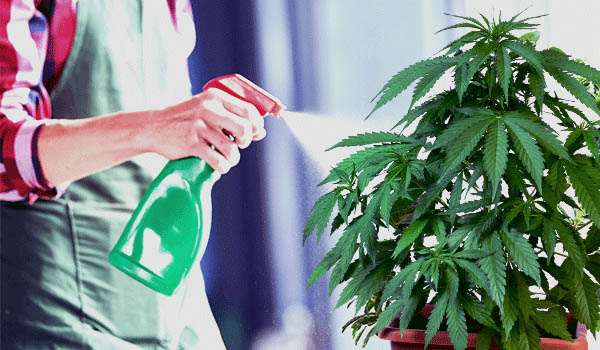
Avoid adding foliar feeding during the hottest parts of the day.
How to Foliar Feed Cannabis Plants in Three Easy Steps
If you’re ready to foliar feed your marijuana plants — follow these three easy steps!
Before you begin, you’ll need various tools (depending on your goal, such as correcting a nutrient deficiency or providing a boost of micronutrients). Here’s a list of materials that you must have before you start the foliar feeding process.
- Glass spray bottle
- Plastic syringe/applicator
- Nutrients (grow/bloom/micro/booster)
- Nutrient meter and pH meter
- Mixing container
Do you have all of your tools ready? If so, let’s learn how to foliar feed your cannabis plants!
Step One: Mix Your Cannabis Nutrients
First and foremost, mix your cannabis nutrients.
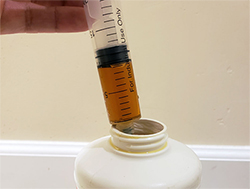
Check the bottled fertilizer bottle and check if the brand lists a recommended dosage for foliar application. A typical example is 5mL of nutrient combined with 1L of water. However, each bottled fertilizer brand may differ, and you must check before creating the nutrient solution.
Remember, always err on the side of caution when performing your first foliar feed and reduce the dosage by one half to one quarter. Therefore, if the nutrient brand’s guideline calls for 5mL, you may mix 2.5mL first. By doing so, you can see how your cannabis plants respond.
tep Two: Check pH and Nutrient Content
Once you’ve created a nutrient solution, it’s time to ensure the pH and nutrient content are on point.
When foliar feeding marijuana plants, you must ensure a pH of 5.7. Furthermore, use the nutrient meter to check the PPM/EC and that it doesn’t exceed 500 PPM.
If you don’t know how to use a pH or nutrient meter, head over to our guides — Why You Need to Use a pH Meter When Growing Weed in Hydroponics, How to Calibrate and Use a pH Meter, and How to Calibrate and Use a Nutrient Meter to learn more.
Once you’ve pH’d the nutrient solution and checked the nutrient content — fill up your glass spray bottle.
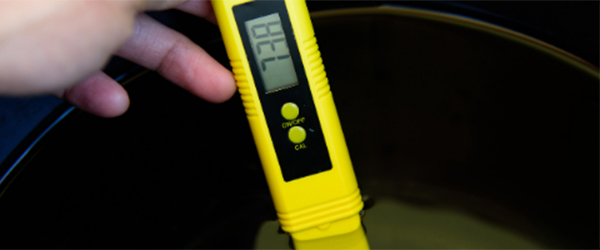
Mix your nutrient solution and take a reading.
Step Three: Spray
Last but not least, it’s time to spray the nutrient onto the cannabis leaves.
However, timing is everything. In other words, you must ensure that it’s early morning or late evening for outdoor cannabis plants. If growing marijuana indoors, you must be ready to foliar feed when the grow lights turn on or a few minutes before the grow system turns off.
Set the nozzle to the spray function and begin spraying down the leaves from top to bottom. You must ensure that the entire cannabis plant is drenched.
Once complete, observe your cannabis plants for the next 6-12-hours. The liquid fertilizer will absorb into the leaves quickly, especially as the garden begins to warm up.
You’ve completed your first foliar feed! Remember, foliar feeding is primarily recommended during the vegetative stage — not the flowering stage.
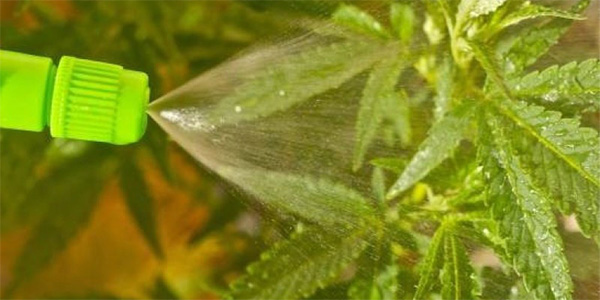
Spray down your cannabis plant top to bottom.
How to Apply Foliar Fungicides or Insecticides On Cannabis Plants in Three Easy Steps
Whether or not you spotted spider mites or powdery mildew — applying organic insecticides or fungicides is an excellent method to safeguard your cannabis crop.
From preventative measures to stop an outbreak in its tracks, natural pesticides and fungicides are an integral piece of your overall cultivation strategy.
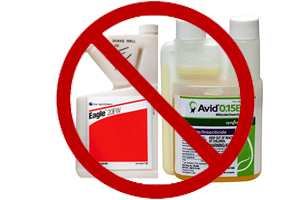
Do not use dangerous chemicals like Eagle-20 or Avid.
Remember, you and your loved one’s health is in your hands — avoid dangerous foliar sprays at all costs.
We do, however, recommend the use of natural insecticides and fungicides that incorporate neem oil, copper sulfate, and other environmentally-friendly products.
Without further ado, here’s a list of tools needed to apply foliar fungicides or pesticides on cannabis plants:
- Glass spray bottle
- Plastic syringe/applicator
- Natural Pesticide/Fungicide/Bactericide
- Mixing container
Step One: Read the Instructions
First, read the instructions located on the bottle. Whether you’re using neem oil or a brand that harnesses copper sulfate, the instructions will provide clear guidelines that you must follow.
In general, it’s not recommended to spray cannabis plants that are in full bloom. However, you may be forced to in the event of a severe outbreak. If you absolutely must spray your weed plants during flowering — only use natural and organic pesticides or fungicides.
Depending on the brand’s recommended dosage, use the plastic syringe and mix it with a corresponding water amount.
Step Two: Put the Solution Into a Spray Bottle
Next, funnel the solution into the glass spray bottle. For maximum effectiveness, make sure you shake the bottle before use.
Step Three: Spray Your Cannabis Plants
Like foliar feeding, you must ensure that you apply pesticides or fungicides early in the morning (lights on) or in the evening (before lights off).
If applying the foliar spray outdoors, do not spray if:
- It’s windy
- It’s raining
- If there are people or animals nearby
If applying the foliar spray indoors, do not spray if:
- The oscillating fans are at their maximum level
- If there are loose or exposed wires from the grow light system
Spray down the cannabis plant(s) from top to bottom, and make sure you also spray the leaves’ undersides. Make sure the cannabis plant is dripping with protectant.
Once done, leave the grow room or cannabis garden and allow the protectant to absorb onto the leaves.
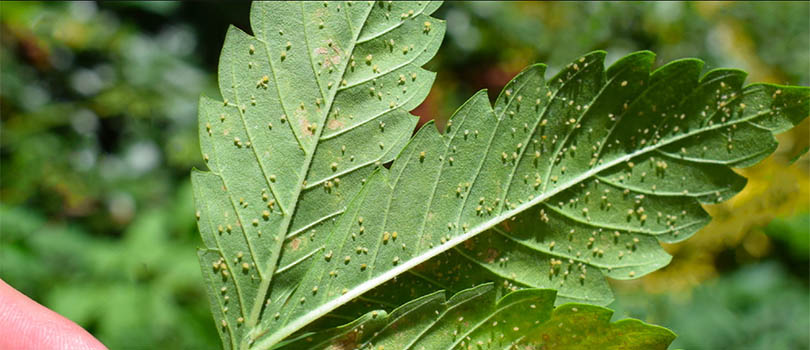
Don’t forget to spray the underside of your cannabis leaves.
A Bigger and Better Harvest To Come
By learning how to foliar feed or spray protectant on cannabis plants — you’re set for a bigger and better harvest than you’ve ever experienced.
From massive buds drenched in resin to glorious terpene content — you’ll be surprised by the effectiveness of foliar feeding in the days to come.
Remember, foliar feeding is a supplemental method to feed your cannabis plants. Furthermore, it allows cannabis cultivators to quickly and efficiently pump protectants into the marijuana plant.
Ultimately, foliar feeding and spraying is another tool in your toolbox as a cannabis cultivator. As you increase the number of “tools,” you’ll become a true cannabis green thumb that can adapt to nearly any situation in the grow room.
